Costa Blanca climbing: review and notes
Dates
Second and third week of May 2014
Summary
With the worst of winter finished we started thinking of a destination for some 'start of season' rock climbing. You only have to look on-line and at the climbing magazines to realise that Spain is a very popular destination. Well known for cheap and sunny rock climbing. It sounded great, tempered with a bit of concern over how noisy the resort town would be.
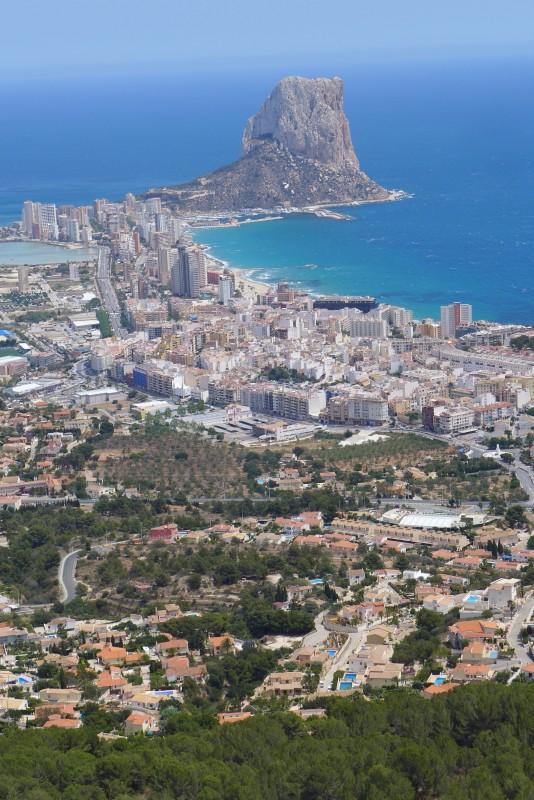
The outcrop of Penon de Ifach and the rest of Calpe
As it turned out the town was fine, with few tourists there so early in the season. We benefited from the infrastructure as there was lots of accommodation available and the roads were easy to use. We stayed in a lovely small apartment which had great facilities and had its' own pool. The area and town were not as culturally interesting as Sicily (May 2013), but it was perfectly relaxing and quiet.
Where Costa Blanca really showed itself off well was in the climbing. There's a very large area to explore with around 35 crags, spread over hundreds of kilometres. According to UK climbing there are over 2,500 routes in the area. In a two week trip we barely started to scratch the surface at any individual crag and only visited a handful in total. There's also a range of multi-pitch sport climbing for those that want a bit more adventure.
In summary, if you're looking for an logistically easy and straight-forward climbing holiday, with plenty of sun and variety then Costa Blanca is a great option.
Highlights & Lowlights
+ Easy to travel, with a variety of airlines
+ Variety and rich set of routes, both sport and sport multi-pitch
+ Travelling to the various crags is easy with GPS and good roads
+ The weather is lovely and the area beautiful
- Resort towns are a bit soulless
- Travelling to different crags can take a while - it's a big area
- If you're looking for a secret paradise this isn't it - it's lovely ... and everyone knows it
Travel
The south of Spain is very easy to get to, with multiple airlines flying there. There are budget flight options from the likes of Easyjet.
We flew British Airways from Gatwick to Alicante on Saturday morning. Alicante airport is very large and it's well prepared for a significant volume of travellers. Luckily, it wasn't that busy in May. It was straightforward picking up a car that we'd pre-booked.
To travel to Calp it takes about an hour down a very well sign-posted motorway, past Benidorm. In general, the roads are easy to read and well maintained. There wasn't that much traffic on the roads most of the time which made things a lot easier. Compared to other countries the ease of getting around was one of the positives.
We took a GPS unit (Garmin Nuvi) that has the ability to use co-ordinates which helped a lot in driving to the various climbing locations as the guide book provides GPS co-ordinates for parking. There were a couple of times where the virtual maps and the roads weren't correct, mostly in the depth of the housing areas. Including a famous incident of having to do a 50 point turn in a teeny-tiny house entrance. But, in general it was easy to navigate.
Accommodation
The Costa Blanca has so much accommodation the options are almost overwhelming.
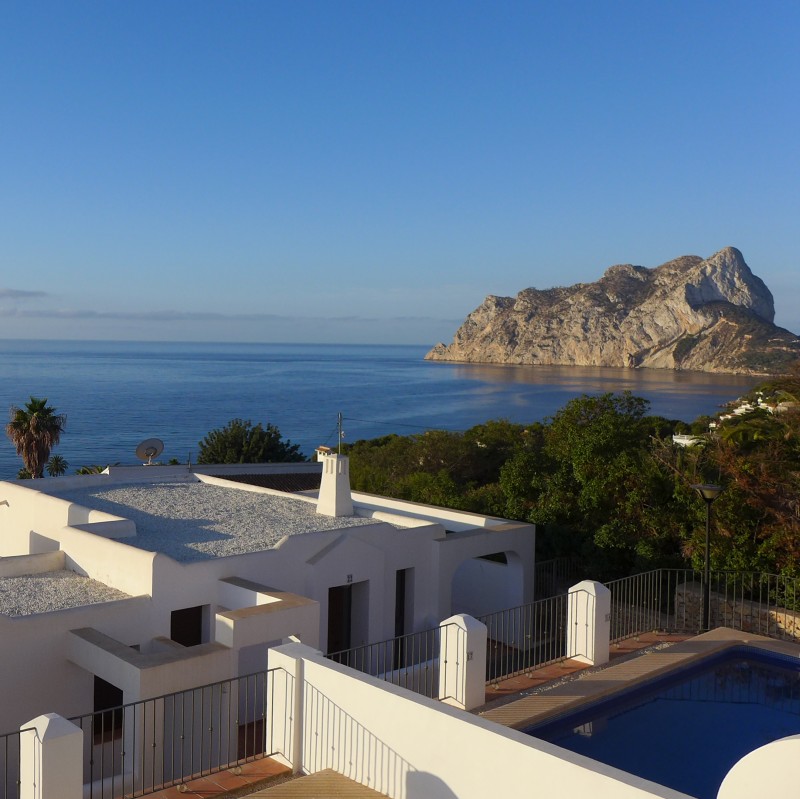
The view from the apartment in Calpe
We chose Calp because it's broadly at the centre of where the climbing is. This is a very large area, with climbing (in the guidebook) spread over hundreds of kilometres. Consequently, the options for where you base yourself are varied.
We chose to be on the coast which was lovely, and it was easy to get to the beaches. Some of the towns in the valleys also looked very nice and less touristy.
In the beach towns the main accommodation is the hotels which put you right on the beach front. The hotels are set-up for volume, so they're very large multi-storey towers.
The other option is an apartment with self-catering. There are a lot (and I mean it) of apartments in the area, so there's a plethora of options. We decided to stay in an apartment. The benefit of the apartment was that there was a bit more space than a hotel room. The self-catering gave us freedom. And, in general it was easy to do as we pleased.
The downside was that we were quite far from the sea and the restaurants. This had quite an impact, as it was just easier to buy food in the supermarkets and as the Internet was good we chilled out watching movies rather than going out. It's probably, quite difficult to get an apartment that is within 15 minutes of the beach.
Calp
Calp and the surrounding towns spread along the coast, with one town merging into another. These are resort towns that cater for thousands of tourists so they have a certain feel to them!
There are hotels in the first few blocks by the sea-front and then apartments and other accommodation spread out behind. The land banks steeply from the sea, so nearly everyone gets a sea view. The number of flats and houses is amazing as the whole coast is scattered with tiny holiday villas separated by winding small roads.
As the towns wind along the coast you can be quite far away from a town centre. For example, we were a long way (40 minutes walk) from the town square of Calp itself. But, each area has plenty of restaurants and supermarkets. As a holiday resort the main attraction is the long sandy beach and the beach front that weaves along the coast, complete with bars and restaurants.
As you can tell, we didn't use the facilities of the town that much. The supermarkets were great with a lot of variety, and we went to a couple of the bars. The rest of the time our flat was too comfortable, and we were too tired to walk into town.
You might get the impression from my description above that it was a horrible resort town experience. But, while it's an area that's ready to handle the crowds, they weren't there in May. That meant we got all the infrastructure advantage, but not the disadvantage. So for us, it was a lovely and quiet experience.
Climbing overview
Reading the guide book it's clear that the Costa Blanca has been developed over a long period of time. There are lots of original, old-school trad routes, many 'early' sport climbing routes and development continues. Multi-pitch sport climbing is very well covered in the guide book with variety of routes from two-three pitches, through to full day outings.
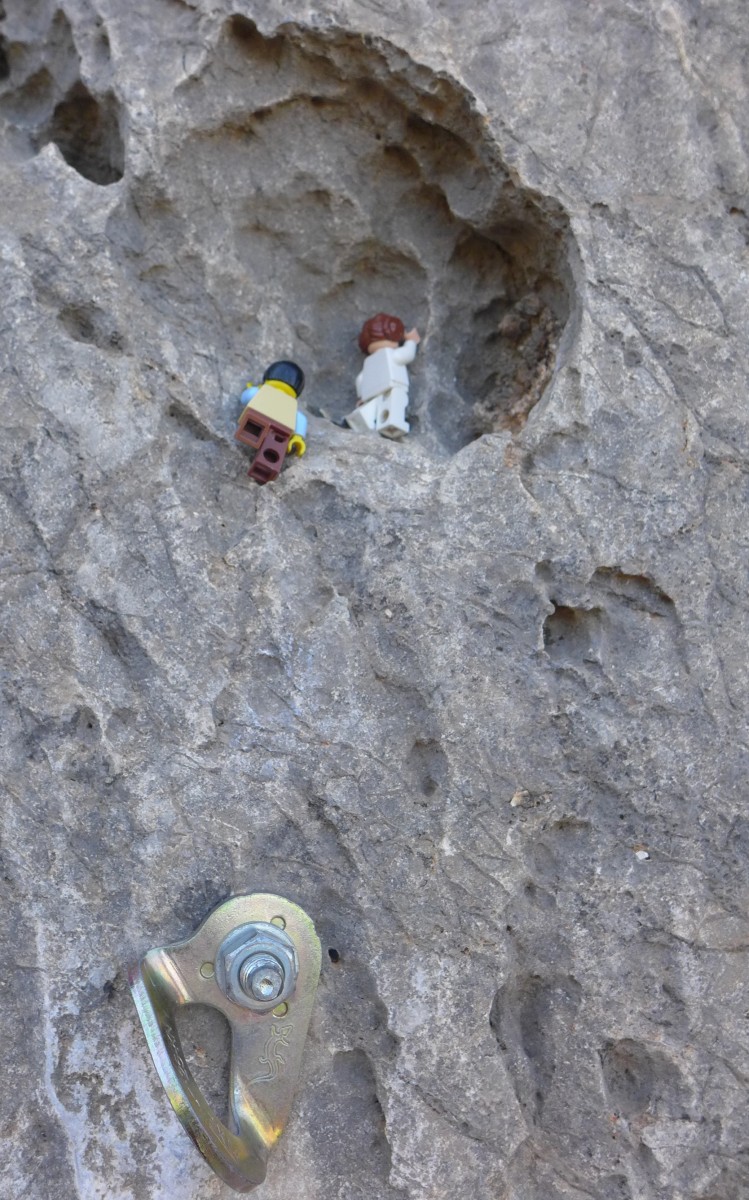
She's always leading!
I had an expectation that the bolting might be a bit sparse and the guide book suggested the need for a small trad rack on some routes. It turned out to be easy to avoid those routes for the single pitch sport climbing. For the routes we did, I would say that in general the first bolt was quite high, and sometimes there was a sparseness of bolting in 'easier' sections of climbs which if you're a beginner would be worry. However, it really wasn't that bad.
As development has been done over a period of time by different climbers and with no central co-ordination you do get the full range of bolts and lower-offs. This particularly shows in the lower-offs. In general, we chose to avoid routes that were 'threads' in the guidebook, because I don't like tatty climbing rope that's been in the sun lots. On the lower-offs front there was only one day where we had to trust single-point lower-offs.
There's lots of multi-pitch sport climbing, which is a key attraction for the area. For this we had two 60m ropes, prusiks, cows tails, lockers and four slings. Although, we used both 60m ropes in order to abseil it wasn't necessary (we just did it for practise) so looking at the guidebook and figuring out if you really need the extra weight would be worth the effort.
We didn't look at any of the trad routes.
Approaches are pretty short and amenable so no big deals. The longest walk-in was 30 minutes, with most being 15 or so. A pair of trainers or sport sandals is fine.
Climbing Gear
- Rope
- You'll need a 60m rope for most of the climbs, as always there are some where you'll need longer.
- Quickdraws
- A standard 18 quickdraws will be fine.
- Helmets
- The wind was pretty high on some of the crags so worth having.
- GPS unit
- If you're using the guidebook then I think this is invaluable for finding the parking at each location. However see the note on GPS reading in the section about Sierra de Toix.
Guidebooks
We used was the 2013 Rockfax Spain: Costa Blanca by Chris Craggs and Alan James. It's a very well done guidebook, with clear photo topography and a well laid-out guide to each crag. If you look at the photos and figure out where they had to stand in order to take the photo-topo you'll start to appreciate how much time and effort the authors have put into guide.
What you lose with a Rockfax guide is there's little on the history of the area or the climbing development. Generally, the logistics and accommodation side is a bit light, but you can find everything you need on the web. There's a review of it on UKC. It was the only guide we used, and it was more than sufficient for us.
Crags overview
There's a full mix of environments to climb in.
The landscape is one of valleys running from the coast into the interior. There are rolling hills and then steep escarpments and limestone cliffs. From a climbing perspective it means there are crags right on the coast where the cliffs end by the sea, equally you can drive up into the hills away from the coast and climb higher up.
The crags we visited are below.
Salem
Salem crag is located about an hour in the Gandia area driving north and into the interior a bit from Calp. It's reasonably, easy to drive to and the access is brilliant as it's a road-side crag. The parking is right off the road, with proper parking area that would fit four or five cars with care. It is slightly higher up in a forest setting, so you get a bit of a breeze but it's pretty well protected.
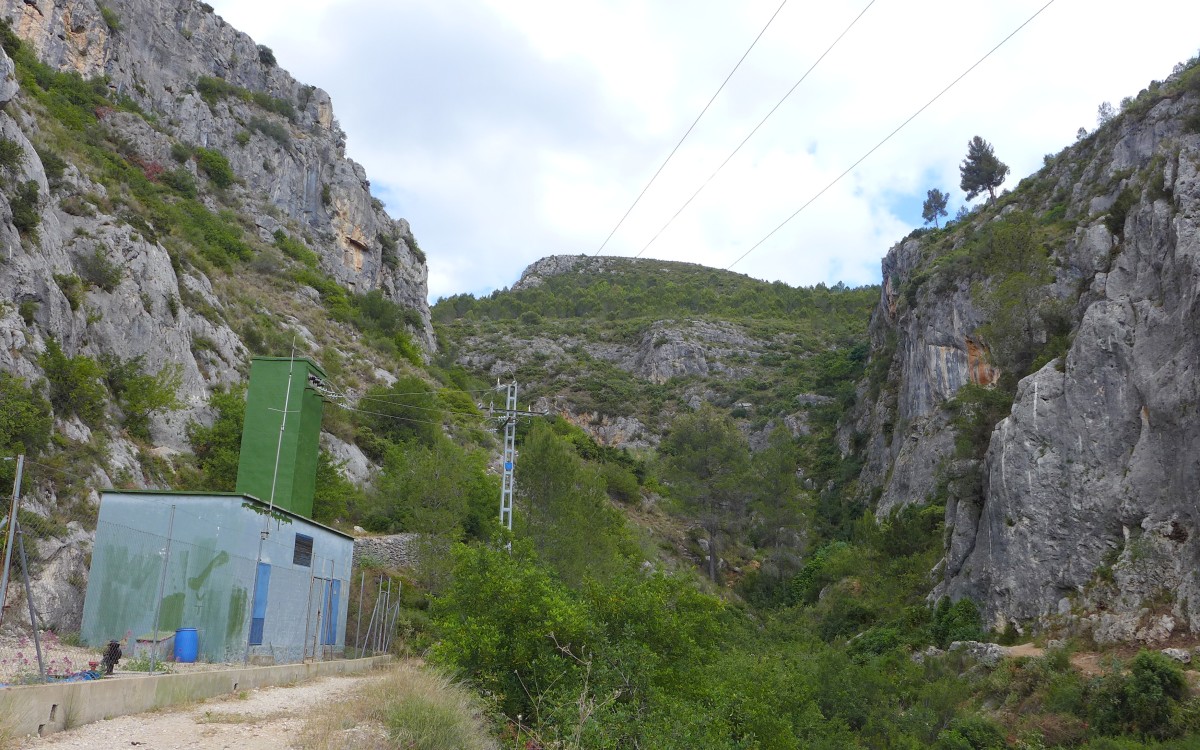
Salem crag, sector Estival just on the left next to the substation
There's about three different sectors you can climb, on both sides of a gully giving sun or shade depending on what you want. The guidebook calls one sector 'Frigido' so you can imagine that it's cold - there was no wind as such, it's just that it's in the shade - honestly I like the shade so it was good for me.
The climbs are some of the better bolted that we found (on-line someone says it's over-bolted which is fine by me!). There were a few 3+ beginners routes for leading, then enough 4's and 5's to keep everyone happy and interested. The range continues up into the 6's where there's a lot of variety. The climbs themselves are on well eroded limestone with plenty of rounded holds that cross some interesting slabs and features. There didn't seem to be much danger of rockfall.
We climbed there twice, on the first day we had it completely to ourselves except for a few dog walkers, and on the second visit there was one other group there. Overall, it was a really nice atmosphere with lots of nature and where quiet appreciation of the outdoors was possible.
Accessible, quiet, with nice climbs in a lovely setting - recommended.
Vall de Guadar / Echo Valley
Echo Valley was one of our favourites, on our "choose one place to go back to" day this location was the unanimous choice!
It's in the Benidorm area, around 45 minutes to get to. The journey was very easy, with only one section through a small town. The element that is not straightforward is the last section where you have to drive up a single-file track which goes steeply up the valley. The guidebook gives GPS co-ordinates to the parking. What you're looking for is a small turn-off (junction) where 5 metres down it there's a parking area that will easily fit 10 cars. We chose to park here and then walked up the steep concrete roadway into the valley for about 30 minutes - the reason we did this is that it would be difficult to deal with passing someone in an unfamiliar car.
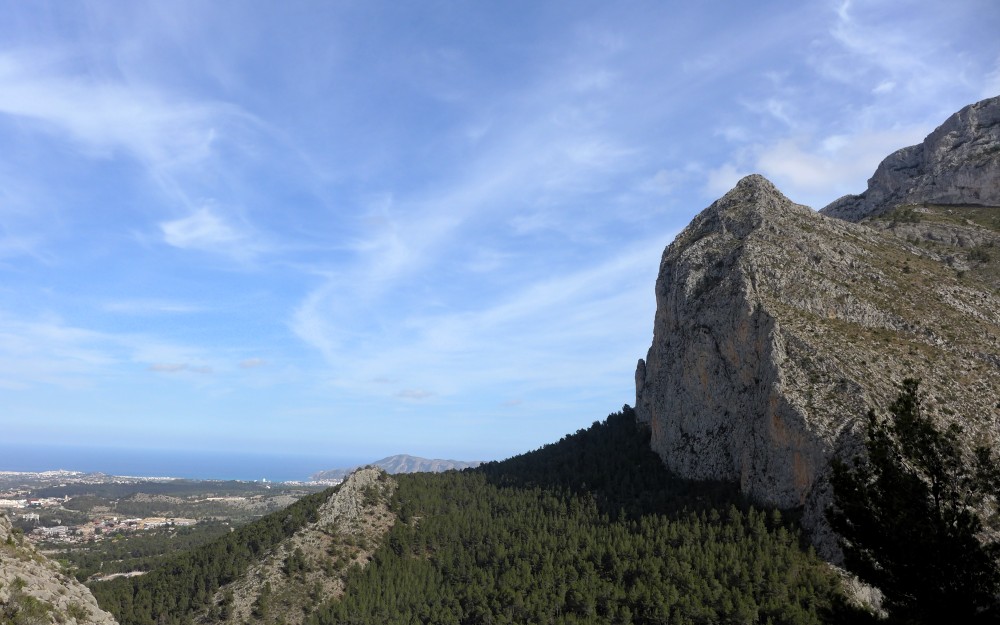
Looking towards the coast from Echo Valley - the rock pillar on the right is an amazing feature.
Alternatively, we saw climbers who drove up the steep concrete road-way and then there was parking at each main sector area for two or three cars at small pull-ins. Details in the Guidebook.
As implied you're really climbing up a very steep valley with zig-zagged road which eventually, goes back to a mountain (or at least big hill) pass. The valley itself is not inhabited, so there's a really nice wild aspect to the area and you have views right down to the coast as well as around you towards some majestic cliffs and crags. According to the signs, it's part of a national park or preserved area of some sort. It really is a lovely location.
It's clearly a popular place for walking and there were climbers at some of the crags each time. However, there are about 5 different areas you could climb at. And each time we climbed we landed up with the whole sector to ourself for the day. The area is big enough to soak up a few people, and not over-crowded at all. The walls and valley alignment mean that you're climbing in the sun, though as you're a bit higher up you get some breeze to keep things cool. If it was very hot then you could find some shade for a break amongst the trees if needed. As it's a big higher we did get some blustery bits and at one point we had to put a thin top-layer on.
The crag we climbed at was set just off the road and easy to get to. The climbs were nicely bolted (some of the best) with good quality lower-offs. The climbs themselves went over well-eroded limestone with lots of water feature pockets and some cracks, so not sharp at all. The climbs were all pretty interesting and it didn't feel like they were over-stacked. They are not marked or indicated in any way so it was a bit difficult to work out which ones were which.
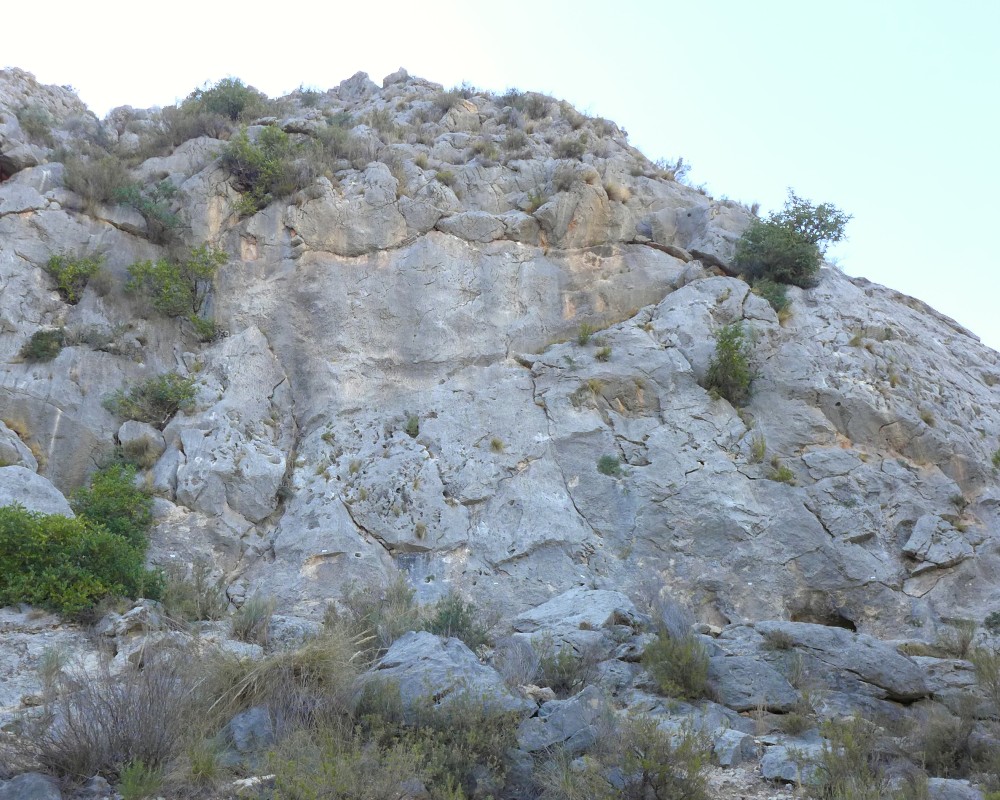
Sector Echo 1.5, centre crack is Regalo por Ali (5) one left X.M.A.S (6a)
The range at our crag (Echo 1.5) was a handful of 3, some good 4 and 4+, a number of 5's and a couple of 6's. I can definitely recommend it to beginner parties. This sector had some of our favourite climbs of the week on it with fun and intriguing moves. Also, my first 6a lead X.M.A.S.
The lower crag which was more popular had much harder climbs in the 6's and 7's which looked like they were very popular. The climbs are pretty well travelled so there wasn't any loose rock, but you are climbing underneath some higher cliffs which in some cases look like there would be loose rock.
The area itself is known for multi-pitch, both sport and trad. We walked up to look at the walls and there's some really lovely red limestone with amazing crack lines and block features. It looks like it would be a lot of fun.
This is fun climbing, in a beautiful high forest location with unrivalled views.
Olta crag
Olta is just outside of Calp on the ridge above so there are fantastic views down to the coast and out to sea. It's obviously very close do doesn't take long to get to. Note, that the drive out of Calp is a bit confusing as you have to cross the funny 'loop' junction, but with GPS and some attention to the signs it wasn't that difficult.
You climb up out of the town across some steep and thin roads right up to the hills above. The GPS co-ordinates took us to right to a car park next to a protected area/national park location with lots of walks - so there was plenty of room and a few people out walking their dogs or hiking.
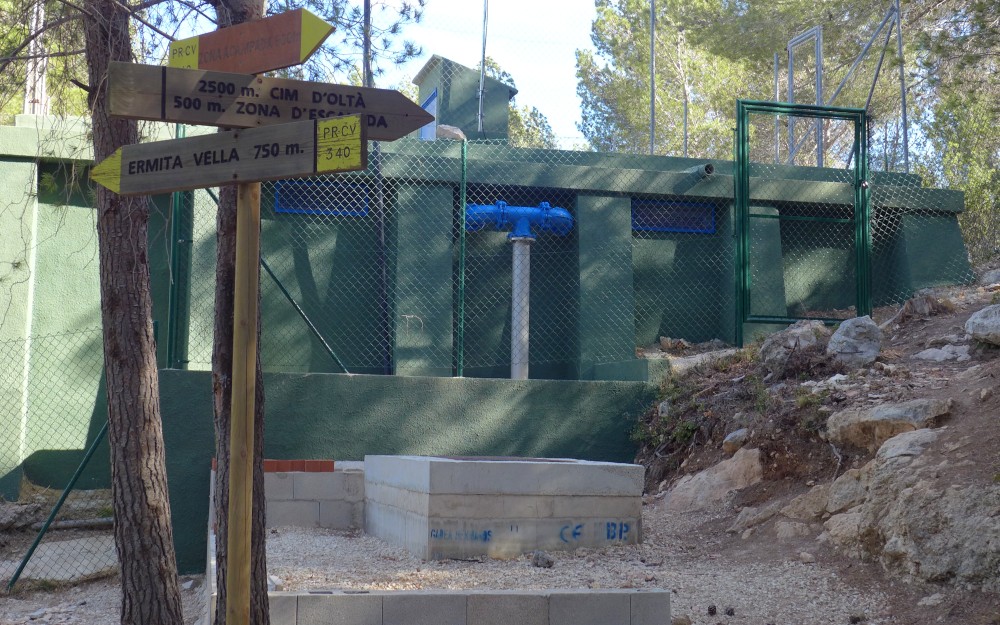
The water station, turn right here and follow the path up next to the fence
This is essentially a forest on the haunches of a long and high rock ridge. The area itself is popular for walking with good gravel maintained paths, so it could be busy - though we only saw a handful of people on the paths below us across a whole day. The walk-in is easy enough (30 minutes) using the paths, though there are a lot more paths than the guidebook shows so it took a bit of careful navigation.
The final section to the climbs steps off the main path at a large pumping station (photo above) and then you walk up through the trees until you get to some paths (with paint dots) up the scree to the climbs. It's pretty easy to figure out where the climbs are as the ridge is easy to see. With some attention the first time you'll find the crag, and after that you'll consider it easy to find.
The climbs are on the side of a rock rampart that runs along as a ridge line. So you're high-up looking right down into Calp and the coast line. As you're so high up and amongst the trees and rock there's a sense that you're with nature, but you can see the tourist town just right in front of you. There's a bit of shade from the wall early on, but most of the time the climbing is going to be in the sun. If it was too much you probably could hunker down in the cooling trees to get some shade.
The weather comes in right over the top of the ridge and the day we were there was blustery to say the least. We had to put on our top layers a couple of times. It all added to the drama!
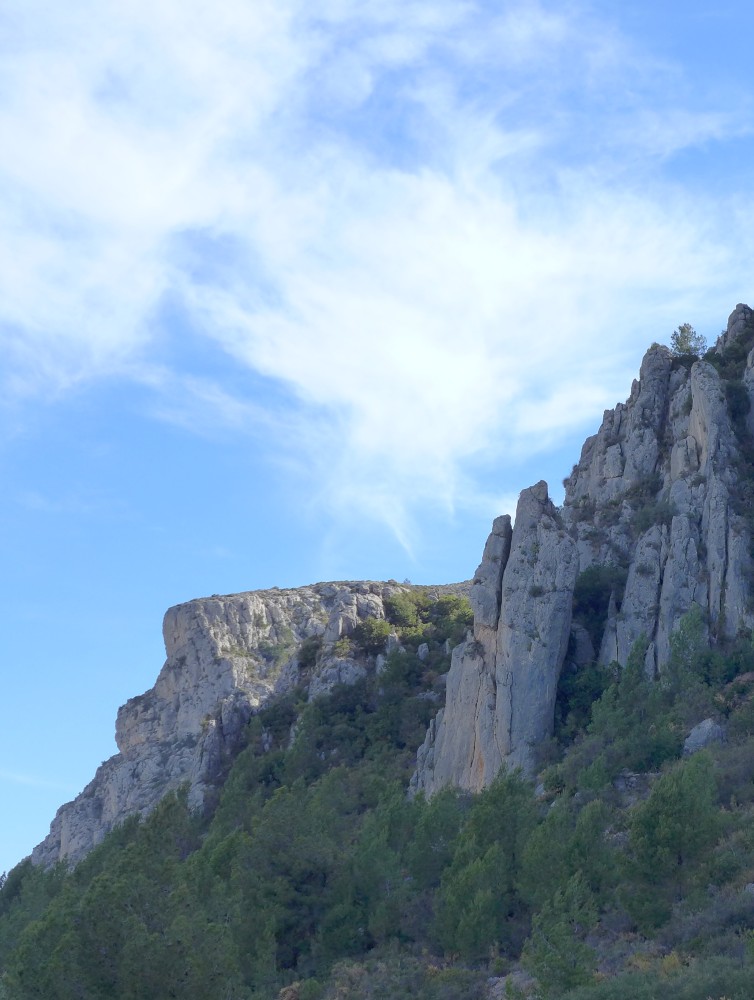
View back down to the lower section of Olta past the rock pillar
The ridge has some very interesting features, with broken columns and mixed grey/light rock. The climbs work along the ridge line and they have their names and in some cases grades painted at the bottom making them easy to find. They are quite clustered and if there were other climbers it would certainly be close company. But, on our visit there was no sign of anyone else - we had both sectors entirely to ourselves.
The rock is pretty well travelled so I didn't find loose rock on the climbs. Though you do have high ridges with a lot of wind above, so the chance of loose rock coming down is moderate. The climbs themselves are perfectly well bolted, I struggled a lot with the lower-offs which are single bolt only. It's a very large ring bolt and there was no sign of rust or other problems, nonetheless I don't like single bolt lower-offs as it's just an unnecessary risk.
We started at Olta South - the climbs were interesting, quite long and vertical. It's a fun sector. The majority of the lower grade climbs in the 4 and 5 range are here. At the second sector (Olta Main) I found some of the grades very hard, one 5 (Best of 95) really felt like a 6 - so be cautious with the grades. I didn't really enjoy this area as it took me by surprise. However, I can appreciate the quality of the climbs, so definitely worth doing.
Perhaps it was the wind, but I found this a really dramatic day in an interesting setting where you felt you'd accomplished something after a days activity.
Sierra de Toix
Sierra de Toix is one of the most popular crags. The guidebook describes this as the raison d'etre of winter sun climbing, and I can see why. It's just a five minute walk from the parking to an escarpment that runs back along from the coast. There are lots of easily accessible climbs across the full range of grades. There are also some multi-pitch climbs that look very interesting.
Oddly, we found this one of the most difficult crags to get to, even though you can see it from almost anywhere in Calp! We drove there once entirely unsuccessfully and just gave up!
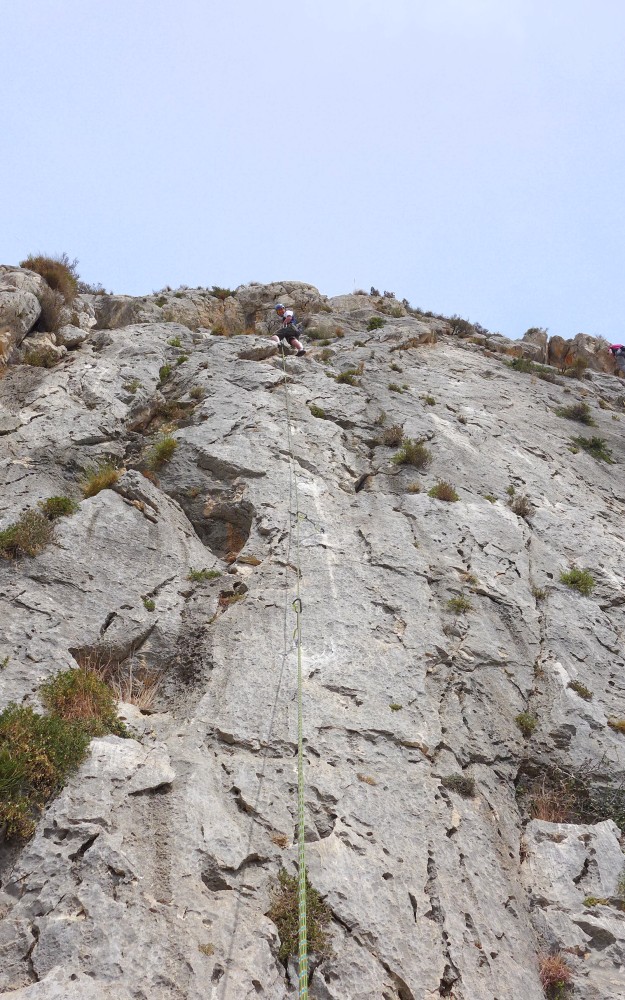
Climbing at Sierra de Toix
There is a reason for this total navigation failure! The first thing to note is that Costa Blanca is pretty much on the east/west meridian so if the east west co-ordinate is -0.XXXX it's a West (that's a minus in front), and if it's 0.xxx then it's an East. As you can guess it took me a bit to figure this out so we were getting odd results on the GPS that put the parking somewhere out to sea, and took us on an odd tour where we couldn't figure out how we were supposed to drive through a private hotel. Make sure your GPS is right!
Second, to get to it you have to drive out of Calp then turn around somewhere (we used a section by the Russian Church), then drive back towards Calp and turn off into the housing area. The turn-off is immediately (and I mean immediately) after a bend, so you really have to indicate, slow down and expect it to be there before you expect it!
It's right up in the tortuous, tiny windy roads of the housing estates, so there's lots of single file driving where you have to be a bit careful. It's worth using the signs for 'Castellet ???'. The Guidebook offers a couple of parking places, and they look close together on the map, they're actually not that close to each other and you couldn't walk between them.
Finally, when you get 'there', there is no parking really. You're on a residential street and there's no official parking, you just have to figure out a place where you're not in anyone's way. Bit of a nightmare all ways round.
Having put you off, I will note that we did climb there twice which tells you about the range of climbs on offer. The Guidebook has details on hundreds? of climbs across the ridge line with a mix of sport and multi-pitch sport. It's a popular location so both times we were there we had other climbers with us, it was positively crowded by Costa Blanca standards - but really this was just a couple of parties and totally fine. You can tell by the paths and flat areas that it's very popular and was one of the first areas bolted.
It's true that the bolting is not 'modern' so the spread is a bit more than you might find on Kalymnos, but actually it wasn't that bad at all. The first bolt tended to be high, and on a couple of occasions there was no bolt over 'easy ground'. I think this would freak out beginners leading for the first time, but perhaps with a clip stick.
The actual climbs are nicely, if closely arranged. Some of them are indicated with some small paint on the bottom which makes navigation of the right area fine and then after that you kind of have to figure it out. Obviously, the climbs themselves are very well travelled so there's no issues with loose rock. The lower-offs were fine as I recall it, with the beginner ones being clip ins.
We practised multi-pitch here with a great little two pitch offering called Bernd. It had good set-ups for abseil and the stations were on nice sized ledges which made it really easy to work with. Recommended.
In summary it's very difficult to find the first time. After you've done it a couple of times it's easily accessible. There's a full-range of climbing options in a sun soaking climbing location.
Marin
Our least successful location!
Marin is set in the Alicante area, it is far from the coast in more of a high desert area. A significant contrast from some of the other areas which makes it worth visiting.
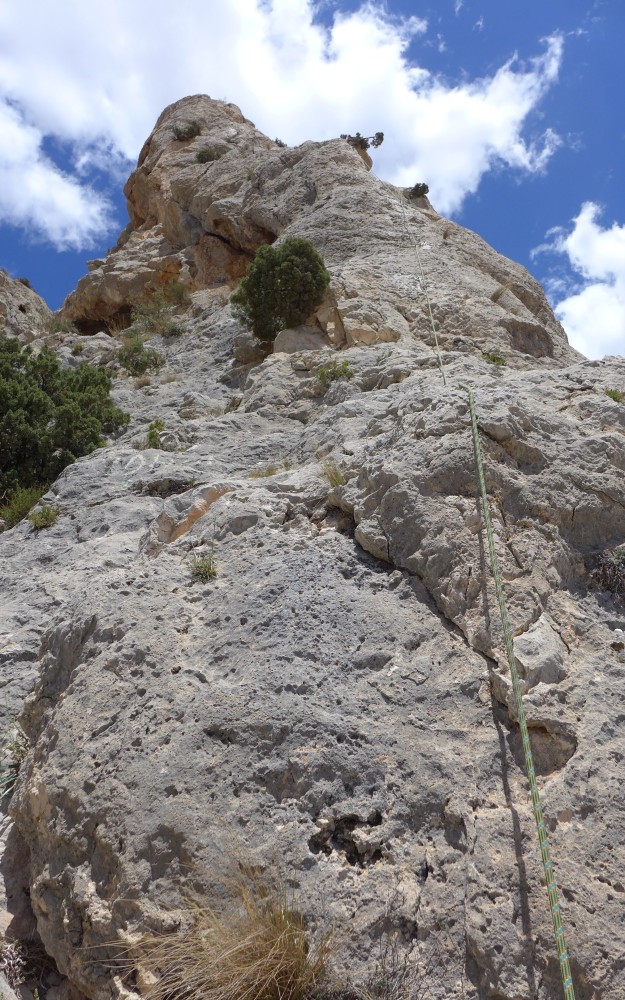
Left hand side two-pitch route (Jhony)
The drive from Calp was long with complex navigation. It probably took 2 hours to get there in total. The route took us along a busy motorway which we found stressful. The GPS had some problems finding the final few roads, so we landed up using the instructions in the guidebook.
The guide did the best possible job of explaining, but be warned there aren't a lot of landmarks to really describe things.
The two main points of confusion are right at the end. The first was that the shape of the road and the GPS didn't line up for the final turn-off (from CV-833), you have to turn-off the main road on a curve slightly ahead of where the GPS thinks you should.
After this you're driving along some small roads through a tiny village and need to find a turn-off to a gravel road. Everything looks similar and the best that can be said is that you're looking for a turn-off with large concrete gate pillars (gate not there) which looks like it leads to someone's house. After you eventually find it you'll see there is a small symbol painted on it to find it - which won't make you feel better! The final section is a long single-file gravel road into an area of forest and ridges used for walking. There is a proper parking area and clear path to walk up to the crag.
We visited to try out the multi-pitch as there's a varied set of two pitch offerings. The crag itself is really interesting with a fantastic cave feature around the back of it. It's slabby with a whiteish rock that is well weathered. It's a completely different feel from the other crags as it's very dry with very little wind. It really feels like you're in a dessert. It was very hot and sheltered on the ground.
We struggled with the climbing, finding the bolting very sparse and overall we had an unsuccessful trip. We only tried one route (Jhony) which is a 4. The first pitch (3+) was enjoyable, it went up an interesting ridge. But, the bolts were sparse which sapped confidence and made navigation a bit complicated. The lower off was hard (impossible?) to find, and it's possible someone had removed the bolts. There are enough alternative lower-offs that we were able to sort things out and abandon the attempt with the use of some mallions - that's why we carry them after all!
My main mistake was launching into the multi-pitch without first doing a single pitch warm-up. In my defense it was supposed to be a 3+. Again some wind added to the dramatic nature!
Looking at the rock generally, some of the routes are very closely joined, it made finding the right way a bit confusing. The bolts themselves are good, there's just not that many of them. Perhaps this was a case where a small rack would have been rewarding.
All in all an awful day. Nevertheless, I'd recommend going there as it was a really interesting crag with a different feel to the others! I think the climbing is probably really intriguing as it winds up some very cool features in what would be a day of multi-pitch adventure.
Food and Amenities
There really aren't any amenities that are worth mentioning. There are some large supermarkets in Calp that we used a lot as they had a lot of food options. Between the supermarkets and the barbeque self-catering was a breeze.
Rest days
- Hang by the pool or the beach
- It's sunny, the sand is beautiful so what the heck! Honestly, this is what we did for our rest days!
- Penon de Ifach
- This is the rock spur that forms one of the ends of the bay. Every photo of Calp has it. There are tunnels and a path you can walk up. Haven't actually done it!
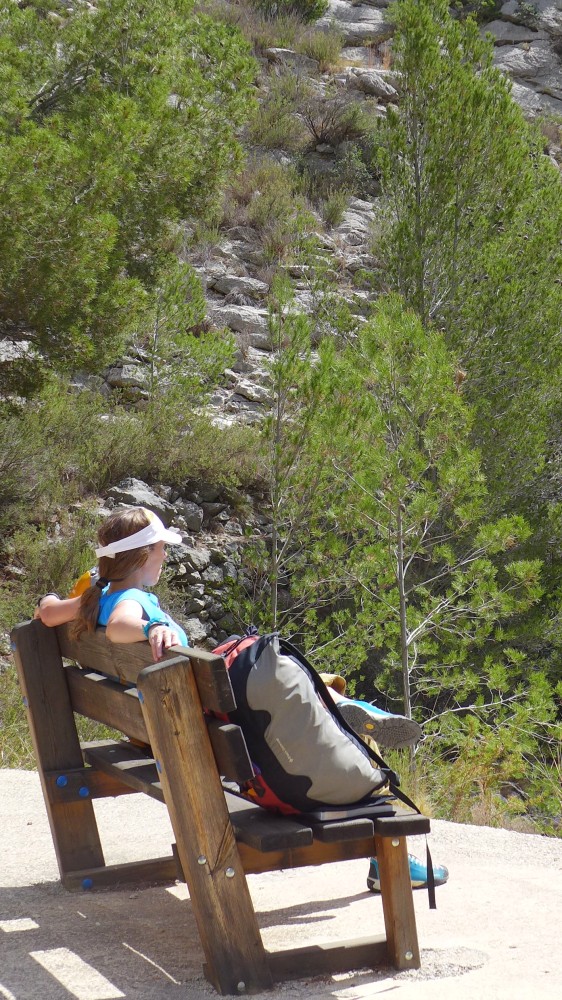
Taking a moment to enjoy the view at Vall de Guadar
- Visit some of the in-land towns
- Adventurous souls will find things to explore in the towns and areas around. There are lots of Tourist Offices where you can get information.
Hints and Tips
- Hire a car
- You can't climb here by using public transport, and it won't work using a moped. A little car is the only way.
- GPS
- Get one, check it uses co-ordinates and has Spanish maps loaded. See my notes above about using co-ordinates.
- Maps
- No maps needed - signs and GPS are sufficient.
Resources
There's a variety of useful resources out on the Web, here are the best ones that I found.
- Climbing, Costa Blanca, Spain, 1 through 13 August 2006
- Great blog post.
- Rockfax, Costa Blanca area information
- General information on Costa Blanca from Rockfax.
- Costa Blanca crags
- Breakdown of the crags.
- Costa Blanca Climbing
- Some general information and lots of information on the routes which is a good back-up to the Rockfax info.
- Accommodation in a self-catering house
- The site has lots of good information about the area and some nice photos.
Comments
If you have comments on the content or climbing in Costa Blanca please leave them below.
blog comments powered by Disqus